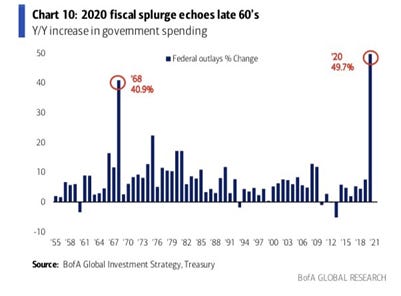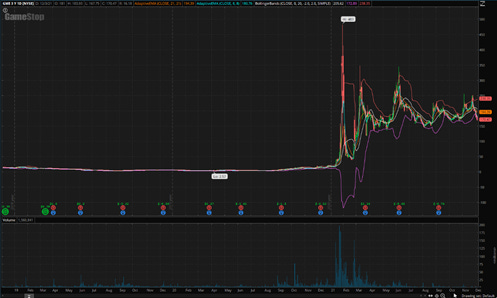We're Not in Kansas Anymore
The type of generational gains we saw in 2020 don’t last forever. Detailed analysis below.
To: Marlin Capital Clients
“We’re Not in Kansas Anymore”
In The Wizard of Oz, Dorothy suddenly finds herself in a strange and unfamiliar environment. Investors who easily outperformed the market in 2020 are finding themselves in a similar situation right now. Following the March 2020 Covid lows, the potential of easy money has powered an explosive run, culminating in generational gains for many tech stocks. But now, the music has stopped.
Last week, I officially opened up my Bear Market playbook. Yes, the Bear has not hit the indices yet. It might be awhile before it takes the S&P 500 down 20%. The indices, in my opinion, will be the last domino to fall. In the meantime, the Bear is hitting the highest valuation stocks first, as is quite evident in the below graphic.
How did we get here?
The signs were always there in front of us. Sometime during the March 2020 Covid crash, the Federal Reserve cut rates to 0 and launched a massive $700B QE program. A few weeks later, the bubble began to form.
Truth be told, one of my favorite parts of the Bubble had to be receiving texts about GME and AMC from numbers I did not recognize. It turns out, these were people I had met once or twice in my life, who had never invested in or traded stocks before. Suddenly, they were drawn to the market by the promise of fast and easy money.
Of course, I knew this type of mania was not normal, but I tucked that thought away as something I would worry about at a later date. After all, the party was just getting started.
This was just 1 sign of a bubble, though, and there was a list of many.
1. Record Fiscal Stimulus: The government pumped record amounts of fiscal stimulus into the US economy.
2. SPAC Mania: This was perhaps the greatest sign of excess and greed. No one had ever heard of a SPAC before, but suddenly, pre-revenue companies were soaring 500%+ in weeks on false promises and management’s 2028 revenue projections.
3. Quantumscape (QS): The poster boy of the SPAC mania. The stock climbed from $13 to $133 in 1 month, a 933% gain. As we can see, the “king of speculation”, QS, was one of the first dominoes to fall, peaking in late 2020.
4. Nikola (NKLA): The fraudulent pre-revenue EV startup gained 623% in a month. They promised they were the next Tesla, not the next Enron.
5. Retail Mania – Wallstreetbets: Highlighted by the GME and AMC short squeezes, the WallStreetBets subreddit gained instant fame. These pioneers showed the masses how easy it was to make money during the Bubble.
6. GME, AMC, and “Meme Stocks”: It was pinned as retail investors against hedge funds. This was the opportunity for retail investors to strike back. 18 year olds were suddenly outperforming 30 year Wall Street veterans by purchasing the most popular “Meme Stock” of the day. Some won big, and many lost big, just like any bubble.
7. IPO Mania: New IPOs like SNOW, ABNB, etc. were doubling and tripling before their debuts. When Airbnb CEO Brian Chesky was told, on live TV, the price that ABNB stock would begin trading at, he could not even contain his disbelief.
8. Chamath thinking he was the next Buffett: This is definitely one of my favorite memories of the Bubble. Chamath rose to fame as the “King of Spacs” and the “Next Buffett”. As it turns out, he was mostly just unloading garbage to unsuspecting retail investors. Buffett had Geico, and Chamath had Metromile.
9. Software and Tech Outperformance: Tech outperformance versus the S&P 500 reached areas not seen since the very top of the Dot Com bust.
Meanwhile, at its peak, the software ETF “PSJ” achieved over 80 percentage points of alpha over the S&P 500. Most all those gains came during the parabolic post-Covid bubble.
Note that the peak came in February along with the more speculative areas of the market.
10. All Time High Valuations: Multiples expanded to all-time highs across the board. Many really believed it was different this time.
Once again, we hit a peak in February.
11. “It’s different this time” – We heard a lot of this over the past year. Many rationalized the ATH valuations because of the new digital paradigm, new/superior business models, and the new economy. In every bubble, there is always the belief that something has changed permanently. Investors become exuberant, and valuations fall to the wayside. It’s always “different this time”. That is – until it’s not.
12. Buzzwords – “Digital Transformation”, “WFH”, etc. - Yes it’s true, these are very real things. The companies that benefitted deserved to see their stocks go much higher. But, human psychology and greed always tend to take things a little too far. The internet was a real thing too, but investors got carried away in the late 90s as a speculative bubble ultimately formed. This time around, human nature led to a similar pattern of wild speculation and excess.
The Bubble Bursts
I was hoping for one more melt up rally. A blowoff top. I was gearing up for one last championship run. After all, the Fed is just beginning to taper. But, in the market, things never go the way you plan.
Many investors were aware that we have been in a bubble. Most knew that these types of gains, in this short of time, are not normal. Most knew that these types of valuations are also not normal.
But the consensus seemed to be that we had nothing to worry about until the Fed started to raise rates. Then - people said, the bubble “might” burst. The consensus was that we’d melt up into year end, like we always do. The consensus was that we’d have 1 last hurrah - a blowoff top where it would be painfully obvious that the market had just topped. The funny thing about the market, though, is that it has a way of proving the most amount of people wrong.
The fact of the matter is, the unwind of high valuation stocks began last February. ARKK, my proxy for growth stocks, capped off a parabolic run from $33 to $160 in less than 1 year. It is unheard of for an ETF to gain 385% in 4 years, let alone 1.
ARKK peaked in February, followed by an initial wave down. Then, ARKK consolidated for the rest of 2021 while many growth stocks broke out to new highs. It seemed as if ARKK would also break this long consolidation to the upside. But, as it turns out, ARKK broke the other way.
As I’ve discussed from a technical standpoint, my first price target for the ETF remains $78 and in a more painful scenario, $44.
It is important to note that stocks do not go from a Bubble to Fair Value. Instead, the bubble bursts, and by the time the indices crack, it will have been too late in the most speculative of names. The bubble has been bursting for awhile right under our eyes.
Stocks and markets move in cycles. During this bubble, we had a significant overshoot beyond fair value, in my opinion, to the upside. Now, we are heading for a significant overshoot to the downside. Eventually, stocks will revert to the mean and nature will have healed itself.
What’s next?
So where does that leave us? I mean, ARKK is already down 41% from its February peak. There is no playbook that says tech stocks must decline by the same amount now as they did during the Dot Com bust. This bubble is unique, and it’s already been bursting. It does not have to follow the Dot Com bust to a tee, like it has been in the graphic below.
Again, I come back to the $78-$80 level as my first price target. At $78, ARKK would be 51% off its February highs. So, the ETF went up 385% in 1 year and then will have declined 51% the next year. A 51% decline in a year certainly qualifies as a bubble bursting. So, is that enough then? Will it finally be over?
The short answer is no one knows. All we can do is analyze the price action and look for potential signs of a bottom.
As I’ve mentioned, there is a more bearish scenario on the table as well. This scenario includes ARKK coming all the way back to $44. As you can see in the above overlay, the ARKK bubble matched the Dot Com bubble gain for gain. Now, will it match it loss for loss?
Again, the short answer is that no one knows. One of the keys to success in the market is staying open minded and being flexible. That is precisely why I will continue to follow the price action and let the market tell me when it is ready to bottom. If ARKK slices through the $78-$80 level, the $44 level starts to become more and more of a possibility.
Summary Points
We are in a Bear Market
The bubble started to burst last February
Most speculative assets peaked 1st (SPACs, FUBO, etc.)
Breadth weakened while some growth stocks had 1 last melt up
The Fed pops bubbles
The indices will be the last domino to fall
Be prepared for tougher sledding ahead


















Very insightful report....most importantly...your research/analysis is quite understandable...even for those of us not professionally in the financial markets ...perhaps your best stuff to date...keep up the good work....
Extraordinary piece of work David. Good reminder of all the ridiculousness in the bubble. I have to say I did get drawn into some of the excesses myself and did not fully escape unscathed. I started investing in individual growth stocks seriously in Sept 2020, by Feb 2021 I was up 45%, and here we are today I am flat for the year. Thanks to a few of you folks I didn't at least get to negative territory. Lots of lessons learnt in a year though, so some silver lining maybe. Looking forward to some more lessons as this bear unfolds and the bubble pops until people lose hope. Most people I feel like are still expecting this is just a dip along the way.